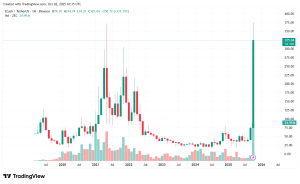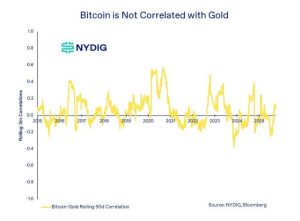A Wall of Capital Awaits: Why the Next Liquidity Cycle Could Propel Cryptocurrencies to New Heights

Summary (Approx. 100 words)
As global markets prepare for the next monetary easing cycle, analysts suggest that a substantial flow of institutional and retail capital could soon enter the cryptocurrency ecosystem. With inflation showing signs of moderation and central banks signaling potential rate adjustments, investors are re-evaluating digital assets as both speculative opportunities and hedges against fiat devaluation. Cryptocurrencies, once dismissed as volatile outliers, are now viewed through the lens of liquidity cycles, risk diversification, and technological adoption. The confluence of macroeconomic shifts, regulatory evolution, and renewed investor confidence could set the stage for a transformative inflow of capital into the crypto sector.
Global Market Outlook: A Changing Financial Climate
The global financial landscape is undergoing a structural realignment. As major economies confront a plateauing of inflation and slowing economic growth, central banks are gradually softening their monetary stances. This shift—marked by potential interest rate cuts and increased liquidity—typically triggers renewed appetite for risk assets.
Cryptocurrencies, historically sensitive to liquidity trends, stand poised to benefit. In previous cycles, easing financial conditions correlated with surges in Bitcoin, Ethereum, and other leading digital assets. With vast pools of sidelined capital—estimated in trillions of rupees—awaiting deployment, the digital asset market could experience a liquidity-driven resurgence reminiscent of the 2020–2021 boom.
Institutional Capital: The Quiet Catalyst
One of the most significant undercurrents shaping the next crypto cycle is the growing involvement of institutional investors. Pension funds, hedge funds, and sovereign wealth entities are increasingly allocating small but meaningful portions of their portfolios to digital assets. The introduction of regulated exchange-traded funds (ETFs) and clearer compliance frameworks has further legitimized cryptocurrency investment.
Institutional inflows, unlike retail speculation, bring stability, liquidity, and credibility. Once large asset managers perceive crypto as a viable component of diversified portfolios, the ripple effect could elevate valuations across the sector. If current projections hold, even a modest 1% allocation from global institutional portfolios could inject billions—if not trillions—into the crypto economy.
Retail Investors: The Return of Speculative Enthusiasm
While institutional engagement provides structural depth, retail investors remain the emotional engine of cryptocurrency markets. Recent data indicates a renewed surge in wallet creation, social sentiment, and participation in decentralized finance (DeFi) protocols. As economic optimism improves, the psychological appeal of rapid digital gains re-emerges, particularly among younger investors who view crypto as a modern vehicle for wealth generation.
Social media, influencer-driven narratives, and community-based ecosystems continue to amplify retail participation. However, analysts caution that sustained momentum will depend on regulatory clarity and macroeconomic stability, both of which influence public trust in digital markets.
Regulatory Shifts and Market Confidence
Regulation has long been a double-edged sword for cryptocurrencies—necessary for legitimacy but often restrictive in implementation. Over the past year, however, several jurisdictions have adopted pragmatic frameworks emphasizing consumer protection without stifling innovation.
This regulatory maturity is fostering confidence among financial institutions and corporate treasuries. Clearer definitions of digital asset classifications, taxation norms, and anti-money-laundering (AML) compliance standards have reduced uncertainty. In India, for instance, discussions surrounding the integration of blockchain technology into financial systems have accelerated, signaling a strategic acknowledgment of crypto’s economic potential despite its speculative risks.
Macroeconomic Triggers: Inflation, Liquidity, and Risk Appetite
The interplay between inflation control and liquidity management remains central to predicting crypto’s trajectory. If central banks resume quantitative easing or lower policy rates, capital traditionally parked in bonds and savings could migrate toward high-yield assets such as cryptocurrencies.
Moreover, geopolitical instability and fiat currency fluctuations continue to strengthen Bitcoin’s narrative as a decentralized hedge. Gold and Bitcoin—once viewed as unrelated—are increasingly compared as parallel stores of value, particularly in emerging markets where currency depreciation erodes purchasing power.
Should global liquidity conditions loosen further, analysts foresee a scenario where cryptocurrencies outperform traditional equities, driven by speculative fervor and technological optimism.
Technological Evolution and Utility Adoption
Beyond speculation, the next market wave is expected to be underpinned by real-world utility. The emergence of blockchain scalability solutions, tokenized assets, and decentralized applications (dApps) has expanded the crypto value proposition beyond mere trading.
Sectors such as decentralized finance, gaming, supply chain, and digital identity management are integrating blockchain frameworks into everyday operations. As practical use cases multiply, investor confidence in the intrinsic value of crypto networks strengthens, reducing dependency on hype-driven cycles.
Outlook: A Tipping Point for Global Capital Flows
The convergence of easing monetary policies, maturing regulation, and institutional adoption positions cryptocurrencies at a critical juncture. While volatility remains inherent, the groundwork for a multi-trillion-rupee liquidity wave is visibly forming.
If this capital influx materializes, the implications extend beyond mere price appreciation. It could redefine global capital markets, integrate decentralized finance into mainstream portfolios, and reshape how investors perceive value creation in the digital era.
For now, cautious optimism prevails. As the financial world prepares for another cycle of liquidity expansion, cryptocurrencies may once again emerge—not as speculative anomalies—but as strategic instruments in the architecture of modern wealth.




